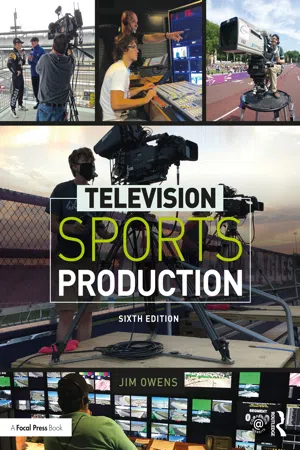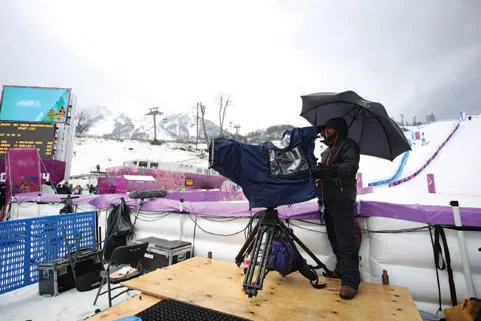
- 282 pages
- English
- ePUB (mobile friendly)
- Available on iOS & Android
Television Sports Production
About this book
In this sixth edition of Television Sports Production, regional Emmy Award-winning producer Jim Owens walks readers through the planning, setup, directing, announcing, shooting, and editing involved in covering a sports event.
Originally written as a training guide for entry-level broadcast staff at the Olympics, this manual gives readers the tools they need to effectively cover sports from ice skating to motorcycle racing. Throughout, Owens breaks down all aspects of the production process, revealing the techniques that producers and directors use to bring sports to a worldwide audience. Chapters further include tips and advice on using the latest technologies and tools such as production trucks, REMIs, smart phones, mobile units, cameras, audio equipment, and lighting rigs. Featuring new instructive illustrations and sample forms, as well as testimonials from experienced professionals in the business, this new edition gives readers an inside look at how the experts produce live or recorded television and sports coverage.
This comprehensive book is essential reading for intermediate and advanced students looking to learn how to successfully produce sports broadcasting.
Frequently asked questions
- Essential is ideal for learners and professionals who enjoy exploring a wide range of subjects. Access the Essential Library with 800,000+ trusted titles and best-sellers across business, personal growth, and the humanities. Includes unlimited reading time and Standard Read Aloud voice.
- Complete: Perfect for advanced learners and researchers needing full, unrestricted access. Unlock 1.4M+ books across hundreds of subjects, including academic and specialized titles. The Complete Plan also includes advanced features like Premium Read Aloud and Research Assistant.
Please note we cannot support devices running on iOS 13 and Android 7 or earlier. Learn more about using the app.
Information
PART 1
Introduction to Remote Production
CHAPTER 1
What is Remote Production?

Audio Broadcast Engineer and Mixer
Live-to-Tape
Remote versus Studio Production
What are your responsibilities?
What do you like about your job?
What are some of the challenges you have to deal with?
Table of contents
- Cover
- Half Title
- Title Page
- Copyright Page
- Contents
- Foreword
- Introduction
- Acknowledgments
- Preface
- Part 1 Introduction to Remote Production
- Part 2 Planning
- Part 3 Creating the Production
- Appendix I Truck Diagrams
- Appendix II Camera Placement Diagrams
- Appendix III Microphone Diagrams
- Appendix IV Production Support Documents
- Appendix V Event Storyboards
- Appendix VI Sports Announcing Article
- Glossary
- Recommended Reading
- Index